

Civil War - The Underground Railroad. Civil War History of the Susquehanna River Towns It was June of 1863.
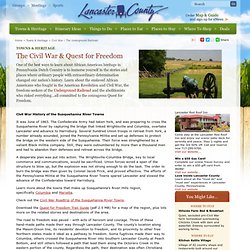
The Confederate Army had taken York, and was preparing to cross the Susquehanna River by capturing the bridge that linked Wrightsville and Columbia, overtake Lancaster and advance to Harrisburg. Several hundred Union troops in retreat from York, a number already wounded, joined the Pennsylvania Militia and set up defenses to protect the bridge on the western side of the Susquehanna. Their force was strengthened by a valiant Black militia company. Still, they were outnumbered by more than a thousand men and had to abandon their defenses and retreat across the bridge. A desperate plan was put into action. Learn more about the towns that make up Susquehanna's River Hills region, specifically Columbia and Marietta. Lancaster County: The People of the Underground Railroad. Daniel & Hannah Gibbons (1775 - 1853) Daniel and Hannah gibbons, a devout Quaker couple, played a pivotal role in the Underground Railroad from their farm near the village of Bird-in-Hand, in eastern Lancaster County.
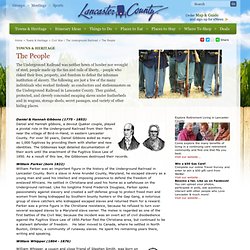
For over 50 years, Daniel Gibbons aided as many as 1,000 fugitives by providing them with shelter and new identities. The Gibbonses kept detailed documentation of their work until the enactment of the Fugitive Slave Law of 1850. Lancaster County Civil War Timeline. The first slaves arrive in Lancaster County.
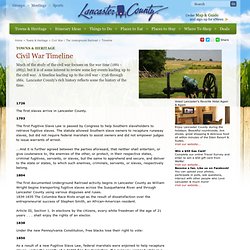
The first Fugitive Slave Law is passed by Congress to help Southern slaveholders to retrieve fugitive slaves. The statute allowed Southern slave owners to recapture runaway slaves, but did not require federal marshals to assist owners and did not empower judges to issue warrants of arrest. Lancaster County Civil War Places and Events. Living The Experience Interactive Underground Railroad Reenactment. Christiana Underground Railroad Center. FREEDOM BEGAN HERE in Christiana, Pennsylvania September 11, 1851!
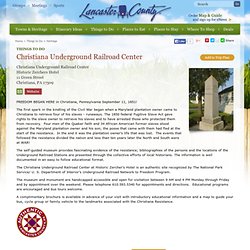
The first spark in the kindling of the Civil War began when a Maryland plantation owner came to Christiana to retrieve four of his slaves - runaways. The 1850 federal Fugitive Slave Act gave rights to the slave owner to retrieve his slaves and to have arrested those who protected them from recovery. National Underground Railroad Freedom Center.
Aboard the Underground Railroad. Flames Across the Susquehanna. Fugitive Justice. Pilgrim's Pathway. Biography of an antislavery city : antislavery advocates, abolitionists, and underground railroad activists in Harrisburg, PA. After five years of research, Todd Mealy has provided a monographic perception of the Antislavery Movement.

By focusing on the struggles between antislavery and proslavery residents of Harrisburg during the first half of the 19th century, Mealy shows that Pennsylvanias capital city was just as important in the movement against slavery as some of the larger, more documented cities like Philadelphia, New York, and Boston. Invaluable for its sources and sweeping account of a single city, this interpretation of antislavery provides a unique look at the partnership between white and black abolitionists, and how we survey the Underground Railroad all together.
Terms of useDescriptive content provided by Syndetics™, a Bowker service. (less) The Underground Railroad in Pennsylvania. Vigilance in Pennsylvania. The underground railroad in Pennsylvania. From Midnight to Dawn : the last tracks of the underground railroad. Chapter OneWilberforce A new black consciousness arose in the decades after the War of 1812.
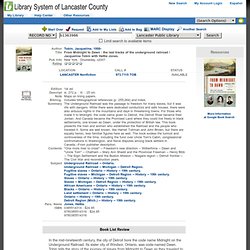
Faced with increased discrimination and violence against them, blacks were no longer waiting for sympathetic whites to protect their interests, but began working actively on their own behalf. Vigilance committees were formed for mutual support and protection; black abolitionist newspapers appeared, representing the thoughts of many free blacks who did not want whites speaking for them.
Fraternal organizations, such as the Prince Hall Masons, which had been in existence since the American Revolution, became even more prominent and proactive. When an “Underground Railroad” was laid, on the paths first trod by courageous forebears who had escaped without any white assistance, many of the conductors were free blacks. Black emigration, an issue since the early nineteenth century, was now being discussed and redefined by blacks who wanted to decide their own destiny. Bearing a letter from James C. Bound for Canaan : the underground railroad and the war for the soul of America. Bound for CanaanThe Underground Railroad and the War for the Soul of America Chapter One An Evil Without Remedy The Negro Business is a great object with us.
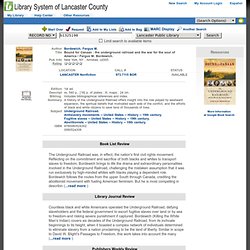
Freedom by any means : con games, voodoo schemes, true love and lawsuits on the Underground Railroad. No one yelled for the sheriff when a free black man named John Bowley showed up at a Maryland slave auction in December 1850.
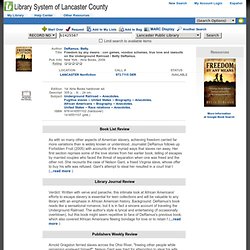
To the small crowd at the Dorchester County courthouse, Bowley was just another black man saying good- bye to the enslaved family he was about to lose. But the thirty-four-year- old husband and father hadn't come to the courthouse to smell his children's fear or kiss their tears. He hadn't come to watch his wife shrivel up either -- all her green hopes gone -- as a slave trader hauled her away. He wasn't that kind of man. He was a man who could build a ship from prime white oak and tar, pegs and passion, and then make it dance with him across the sea. He brought a plan. His scheme would have made a riverboat gambler grin, drag his chair to the nearest poker table and prepare to bluff.
One of Cambridge's most memorable events had been the 1831 hanging of an enslaved woman named Henny. John Bowley had no known history of helping to free slaves. The ties that bind : a memoir of race, memory, and redemption.